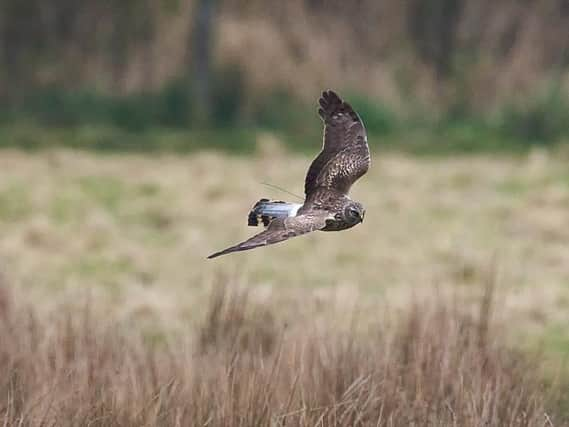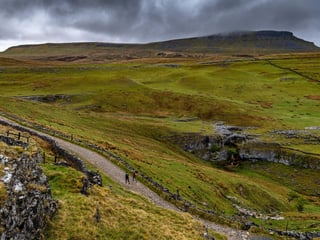Another satellite-tagged hen harrier has disappeared on a Yorkshire Dales grouse moor


The male, named Harold, disappeared in the same area where another juvenile, Dryad, vanished last September.
The moorland between Kirkby Stephen and Ravenseat where the birds' tags stopped transmitting is a grouse shoot in the Yorkshire Dales National Park.
Advertisement
Hide AdAdvertisement
Hide AdA raptor persecution action group obtained the information about Harold's disappearance from a Freedon of Information Act request sent to Natural England, the government body that manages the hen harrier brood management project.
Harold was tagged in June 2020 but disappeared from satellite logs on September 19, around three weeks after Dryad vanished in the same moorland area, although the details have only just been made publc.
Natural England said that the area where Harold was last located was searched by police several times and nothing was found. The investigation remains ongoing.
Since the fate of Harold was revealed on the Raptor Persecution Scotland blog, Natural England have posted an appeal for information about the bird on their official social media channels.
Advertisement
Hide AdAdvertisement
Hide AdA spokesperson for Natural England said: "“Raptor persecution, including of hen harriers, is a national wildlife crime priority and there are strong penalties in place for offences committed against birds of prey. We would urge anyone witnessing or suspecting persecution to contact the police.
“While 2020 saw encouraging signs that hen harrier breeding success is increasing in the English uplands, they remain critically endangered in England and persecution is the main factor in why so many birds don’t reach adulthood. We are a committed partner to the Hen Harrier Action Plan to improve the conservation status of this iconic species.”
Since 2018, 46 tagged hen harriers have gone missing or been confirmed dead, many of them near or on the managed grouse moors that have traditionally wished to deter the raptors, which prey on young grouse.
In September, the Yorkshire Post reported on the fate of Dryad, who was tagged by the RSPB rather than Natural England.
Advertisement
Hide AdAdvertisement
Hide AdThe bird hatched in the Forest of Bowland and has not been tracked since September 7, when he roosted on a grouse moor between Kirkby Stephen and Ravenseat.
His satellite tag had been transmitting his location normally until then. The RSPB searched the area, but no found no trace of Dryad.
Hen harriers, a red-listed species, are legally protected in the UK under the Wildlife and Countryside Act 1981. Yet they remain one of the most persecuted birds of prey in the UK and continue to be illegally killed, or disappear in suspicious circumstances, particularly on or near land managed for shooting.
Scientific research published in 2019, based on the government’s own data, showed that 72 per cent of satellite-tagged hen harriers in their study were killed or likely killed on British grouse moors, and that hen harriers were 10 times more likely to die or disappear over grouse moorland.
Advertisement
Hide AdAdvertisement
Hide AdThe most significant threat to the English hen harrier population - which is now perilously low - is persecution by humans. Twenty-four hen harrier nests were recorded last summer, of which 19 successfully produced chicks, yet there is enough habitat and prey to support 12 times that number.
The wider area, which is dominated by driven grouse moors, has become a ‘hotspot’ for suspicious hen harrier disappearances, as revealed by satellite tagging.
In July 2020 a hen harrier named Harriet, tagged by Natural England, sent her last transmission near Outhgill, just over the border in Cumbria. A further two disappeared, last transmitting near Bowes, County Durham and Askrigg, North Yorkshire respectively in September 2019. And in 2016, the hen harrier Rowan was found shot in Ravenstonedale, Cumbria.
Elsewhere in North Yorkshire, in 2019 the body of another satellite tagged hen harrier known as River was found shot on the Swinton Estate, North Yorkshire.
Advertisement
Hide AdAdvertisement
Hide AdYet when engineering firm NG Bailey ended shooting tenancies on their Denton Hall estate in Wharfedale following several suspicious incidents of wildlife persecution, hen harriers returned to roost on the moor and other parts of the landscape have recovered.RSPB head of investigations Mark Thomas said: “Illegal killing is the number one factor stalling hen harrier conservation in the UK. Despite all the positive news around 60 juveniles fledging in England, this clearly shows the fate of many of these birds once they disperse.
"Sadly we expect further suspicious disappearances in the next few months following the well-established pattern of previous years. If Dryad had died naturally, we would expect his tag to continue transmitting, allowing us to find and recover both body and tag. The sudden stop of satellite tags, particularly considering the history of persecution in this area, strongly points to human interference.
“It is blatantly clear that current legislation is failing to protect our birds of prey and that criminality continues unchecked on grouse moors. The government must act urgently and commit to licensing of grouse shooting with sanctions to withdraw licenses to shoot where criminal behaviours are proven to the satisfaction of the public authorities. Law-abiding estates would have nothing to fear from this approach.”
